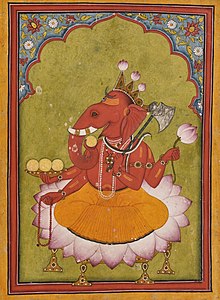
Back Ganesha Afrikaans Ganesha ALS غانيشا Arabic جانيشا ARZ গণেশ Assamese Qaneşa Azerbaijani Ганеша Bashkir Ganésa BAN Ganesha BCL Ганеша Byelorussian
| Ganesha | |
|---|---|
 | |
| Affiliation | Deva, Brahman (Ganapatya), Saguna Brahman (Panchayatana puja) |
| Abode | • Mount Kailash (with parents) • Svānandaloka |
| Mantra | Oṃ Śrī Gaṇeśāya Namaḥ Oṃ Gaṃ Gaṇapataye Namaḥ |
| Weapon | Paraśu (axe), pāśa (noose), aṅkuśa (elephant goad) |
| Symbols | Swastika, Om, Modak |
| Day | Tuesday or Wednesday, Sankashti Chaturthi |
| Mount | Mouse |
| Texts | Ganesha Purana, Mudgala Purana, Ganapati Atharvashirsa |
| Gender | Male |
| Festivals | Ganesh Chaturthi, Ganesh Jayanti |
| Personal information | |
| Parents | |
| Siblings | Kartikeya (brother) |
| Consort | Buddhi, Riddhi and Siddhi or celibate in some traditions |
| Equivalents | |
| Japanese Buddhist equivalent | Kangiten |
Ganesha (Sanskrit: गणेश, IAST: Gaṇeśa), also spelled Ganesh, and also known as Ganapati, Vinayaka, and Pillaiyar, is one of the best-known and most worshipped deities in the Hindu pantheon[4] and is the Supreme God in the Ganapatya sect. His depictions are found throughout India.[5] Hindu denominations worship him regardless of affiliations.[6] Devotion to Ganesha is widely diffused and extends to Jains and Buddhists and beyond India.[7]
Although Ganesha has many attributes, he is readily identified by his elephant head and four arms.[8] He is widely revered, more specifically, as the remover of obstacles and thought to bring good luck;[9][10] the patron of arts and sciences; and the deva of intellect and wisdom.[11] As the god of beginnings, he is honoured at the start of rites and ceremonies. Ganesha is also invoked as a patron of letters and learning during writing sessions.[2][12] Several texts relate anecdotes associated with his birth and exploits.
Ganesha is mentioned in Hindu texts between the 1st century BCE and 2nd century CE, and a few Ganesh images from the 4th and 5th centuries CE have been documented by scholars.[13] Hindu texts identify him as the son of Parvati and Shiva of the Shaivism tradition, but he is a pan-Hindu god found in its various traditions.[14][15] In the Ganapatya tradition of Hinduism, Ganesha is the Supreme Being.[16] The principal texts on Ganesha include the Ganesha Purana, the Mudgala Purana and the Ganapati Atharvasirsha.
- ^ Heras 1972, p. 58.
- ^ a b Getty 1936, p. 5.
- ^ "Ganesha getting ready to throw his lotus. Basohli miniature, circa 1730. National Museum, New Delhi. In the Mudgalapurāṇa (VII, 70), in order to kill the demon of egotism (Mamāsura) who had attacked him, Gaṇeśa Vighnarāja throws his lotus at him. Unable to bear the fragrance of the divine flower, the demon surrenders to Gaṇeśha." For quotation of description of the work, see: Martin-Dubost 1997, p. 73.
- ^ Ramachandra Rao 1992, p. 6.
- ^
- Brown 1991, p. 1 "Gaṇeśa is often said to be the most worshipped god in India."
- Getty 1936, p. 1 "Gaṇeśa, Lord of the Gaṇas, although among the latest deities to be admitted to the Brahmanic pantheon, was, and still is, the most universally adored of all the Hindu gods and his image is found in practically every part of India."
- ^
- Ramachandra Rao 1992, p. 1
- Martin-Dubost 1997, p. 1
- Brown 1991, p. 1
- ^
- Chapter XVII, "The Travels Abroad", in: Nagar 1992, pp. 175–187. For a review of Ganesha's geographic spread and popularity outside of India.
- Getty 1936, pp. 37–38, For discussion of the spread of Ganesha worship to Nepal, Chinese Turkestan, Tibet, Burma, Siam, Indo-China, Java, Bali, Borneo, China, and Japan
- Martin-Dubost 1997, pp. 311–320
- Thapan 1997, p. 13
- Apte 1965, pp. 2–3
- ^ Martin-Dubost, p. 2.
- ^ For Ganesha's role as an eliminator of obstacles, see commentary on Gaṇapati Upaniṣad, verse 12 in Saraswati 2004, p. 80
- ^ DeVito, Carole; DeVito, Pasquale (1994). India - Mahabharata. Fulbright-Hays Summer Seminar Abroad 1994 (India). United States Educational Foundation in India. p. 4.
- ^ Heras 1972, p. 58
- ^ , Vigna means obstacles Nasha means destroy. These ideas are so common that Courtright uses them in the title of his book, Ganesha: Lord of Obstacles, Lord of Beginnings.
- ^ Narain, A.K. "Gaṇeśa: The Idea and the Icon" in Brown 1991, p. 27
- ^ Gavin D., Flood (1996). An Introduction to Hinduism. Cambridge University Press. pp. 14–18, 110–113. ISBN 978-0521438780.
- ^ Vasudha, Narayan (2009). Hinduism. The Rosen Publishing Group. pp. 30–31. ISBN 978-1435856202.
- ^ For history of the development of the gāṇapatya and their relationship to the wide geographic dispersion of Ganesha worship, see: Chapter 6, "The Gāṇapatyas" in: Thapan 1997, pp. 176–213.
© MMXXIII Rich X Search. We shall prevail. All rights reserved. Rich X Search